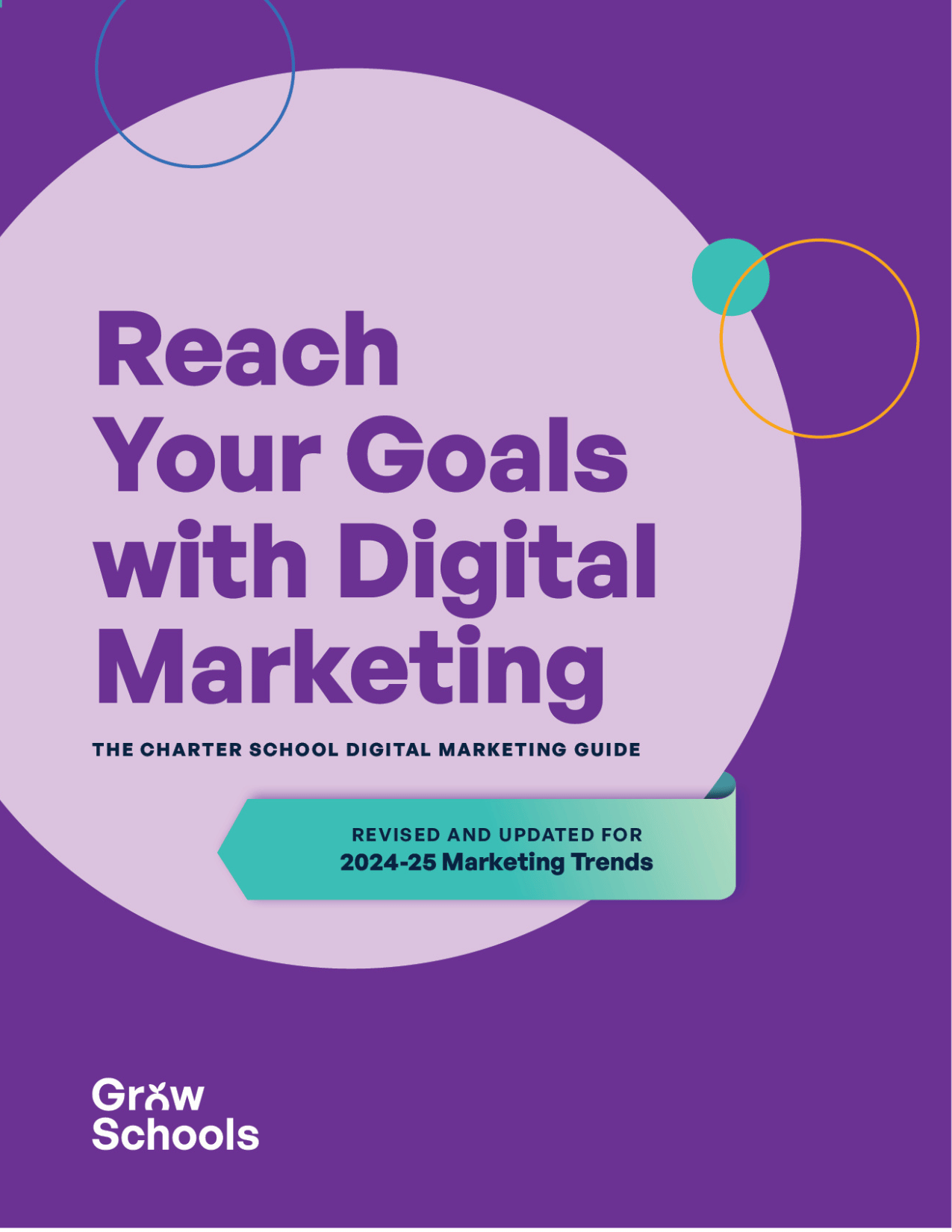The enrollment landscape has fundamentally shifted. With over 8,000 charter schools now operating across the country and even new states like North Dakota opening their doors to charter legislation, competition for students has never been fiercer. Add declining birth rates and families making decisions online before ever picking up the phone, and it’s clear: traditional marketing approaches aren’t cutting it anymore.
The live event,” What’s Trending in School Marketing: Proven Strategies and Enrollment Tactics That Fill Classrooms,” features insights from our enrollment marketing experts and successful school leaders who are seeing real results.
The Truth About Social Media (It Might Surprise You)
Ashley MacQuarrie, VP of Marketing at Grow Schools, opened with what she called a “controversial” truth: no social media platform alone drives qualified leads in 2025.
“Facebook used to be the answer. Instagram was the hot new thing. Everyone’s asking about TikTok,” Ashley explained. “The truth is that those are awareness tools. They’re not lead generators, at least not on their own. Your website converts, your application process converts. Social media can help you get noticed.”
Where Should You Invest?
Facebook and Instagram remain the foundation for school marketing, particularly because that’s where parents—especially moms who are often primary decision-makers—spend their time. Paid advertising on these platforms actually works when used strategically for discovery, while organic content builds the trust and credibility families need before taking the next step.
TikTok is worth exploring if you have capacity, but shouldn’t distract from marketing fundamentals. As Ashley noted: “Go where your families actually are, not where headlines might be telling you you should be.”
Content That Actually Converts
The most powerful content shows your school in action—not stock photos or generic messages. Jesse Foss, Content Strategist on Grow Schools’ Enrollment Marketing team, emphasized that schools should focus on:
- Student testimonials (especially video): Short, authentic clips of real kids talking about what they love
- Day-in-the-life content: Follow a teacher or student through their day
- Virtual tours: Simple phone walk-throughs of your spaces (no drone shots needed)
- Parent voices: Current parents are your best marketing tool
“The goal isn’t to go viral, but to show up as a consistent, trusted and reliable organization for families,” Jesse explained. “Show, don’t tell.”
The AI Question Everyone’s Asking
Yes, you can use AI to help write social posts, emails, and blog content—but with a critical caveat.
“AI can create noise. It sounds very generic, and your school is not generic,” Ashley warned. “If your content could be about any school, it’s not really doing its job. Use AI to overcome blank page syndrome, then edit it heavily. Add specific examples, real stories. AI is a tool. You’re still the storyteller.”

Don’t Panic About AI Search
While headlines warn about AI reducing website traffic, Ashley offered reassurance: “You’re a school. Families will still need to call, visit, and apply. They’re not going to enroll their kid based on an AI answer. Your website isn’t going away. SEO fundamentals still really matter.”
Email Automation: The Easy Win
One of the simplest yet highest-impact tactics? Automated inquiry confirmations.
“If someone fills out your inquiry form, do they get an immediate confirmation?” Ashley asked. “Families want to know their inquiry didn’t just disappear into the void. The automated response buys you 24 hours to follow up personally. Low effort, high impact.”
Email continues to have some of the highest ROI of any marketing channel because families are actively opting in to hear from you.
Measuring What Actually Matters
Jesse emphasized moving beyond vanity metrics: “Followers don’t equal enrollments. Likes don’t equal applications. Shares don’t equal inquiries.”
Instead, track:
- Website visits
- Form fills
- Tour sign-ups
- Where families are dropping off in your enrollment funnel
“If families aren’t converting from inquiry to tour, your follow-up process needs work,” Jesse explained. “If they’re touring but not applying, something in that experience isn’t clicking. Marketing can generate more top-of-funnel activity, but if your funnel leaks, more volume won’t solve it.”
Strategic Content Planning Around Enrollment Cycles
Your content should align with when families are making decisions:
- October-December: Build awareness, showcase your school
- January-March: Active recruitment mode—open house promotion, application info, urgency
- April-June: Application push plus retention focus for current families
- July-September: Welcome new families, prevent summer attrition
“If a family enrolls in February, they have six months before school starts—a really long time to consider if they made the right choice,” Jesse noted. “Use your social media to keep them warm and remind them all summer long why choosing you was a great decision.”
Real Schools, Real Results
The workshop featured two school leaders putting these strategies into practice:
Mike Taack, Founder and CEO of WYLEES (Western Youth Leadership, Engagement, and Empowerment Middle School) in Las Vegas, faced the challenge every brand-new school does: zero awareness in a crowded, competitive market.
“Las Vegas is full of bright lights and distractions, and it’s easy to get overlooked, especially if you’re doing something as mundane as education,” Mike shared. “I knew that Grow Schools had a really high-quality systematic approach to enrollment marketing, and I knew that we needed that to break through the noise.”
Mike’s advice? Start with budgeting for marketing from day one. He wrote enrollment marketing partnership costs into both his state authorization application and federal CSP grant application because he knew it would be critical.
“The hardest part was the timeline of getting enrollments,” Mike admitted. “There’s a critical phase to build awareness and it takes time. It felt tense. But all that front-end investment in sharing our story really paid dividends because we saw a cumulative snowball effect. The awareness was building and building.”
Jonathan Maraweli, President of Jackson Preparatory & Early College in Michigan, faced a different challenge: misconceptions about what his school actually offered.
“I’ve heard everything from ‘I thought it was only a school for smart kids’ to ‘I thought it was an alternative school,'” Jonathan explained. “It was really about setting a foundation of what we are, who we serve, and doing it so that word-of-mouth can really be that biggest lever.”
Jonathan’s school is ten years old and had been experiencing slow but steady enrollment decline despite strong test scores and parent satisfaction. After partnering with Grow Schools on enrollment marketing, they reversed that trend.
“Experience matters, and that’s what families will cite. But it’s interesting because when you put the marketing with it, then they come,” Jonathan observed. “They might not say it was a Google ad that brought them to our school, but maybe that Google ad was the lever that pushed them in the right direction.”
Both Mike and Jonathan emphasized that working with an enrollment marketing partner is exactly that—a partnership.
“It really is a partnership, and it goes both ways,” Jonathan stressed. “You’re not just handing it off. We are Grow Schools’ best tool where we are at. They can give us the ideas and handle a lot of the digital, but we’re the ones doing it on the ground.”
Mike echoed this: “What was really helpful for us was we had a partner to think through how to optimize our ground game, how to take the things we’re already doing and really make them more high-leverage. It really was like having two or three or four extra staff members who are experts in this type of work.”
The Bottom Line
Effective school marketing in 2025 isn’t about going viral or being on every platform. It’s about consistent, authentic storytelling that shows families what makes your school special—and meeting them where they already are online.
As Ashley summarized: “Your school is not generic. If your content could be about any school, it’s not doing its job.”

